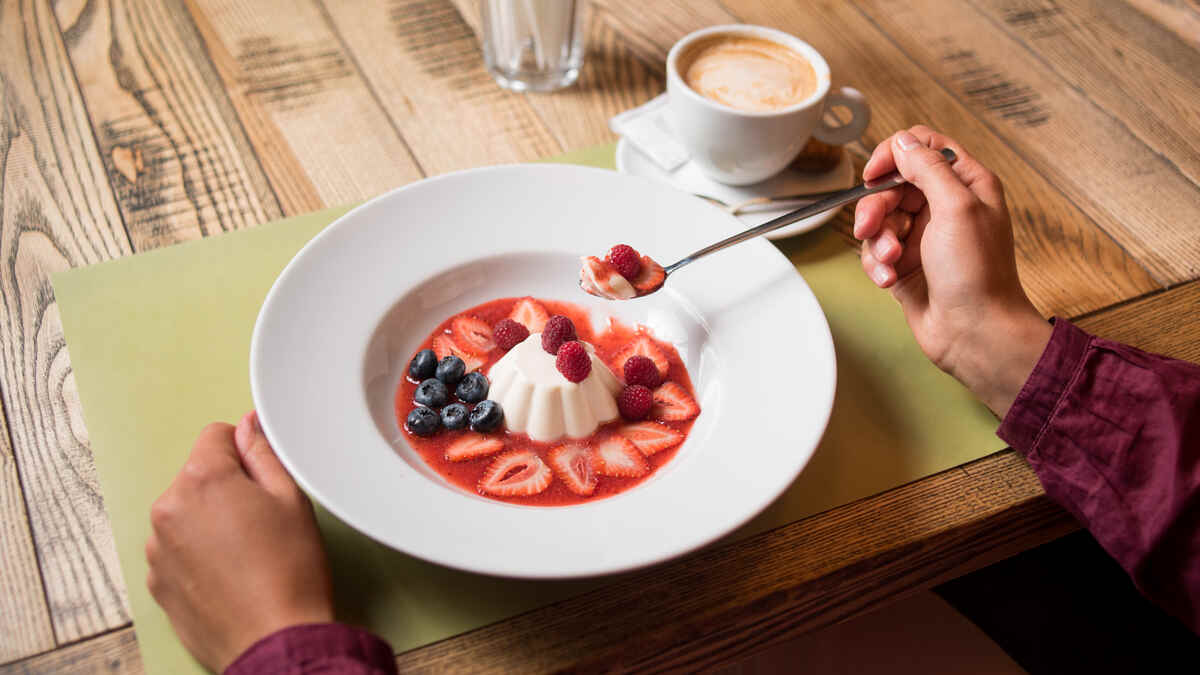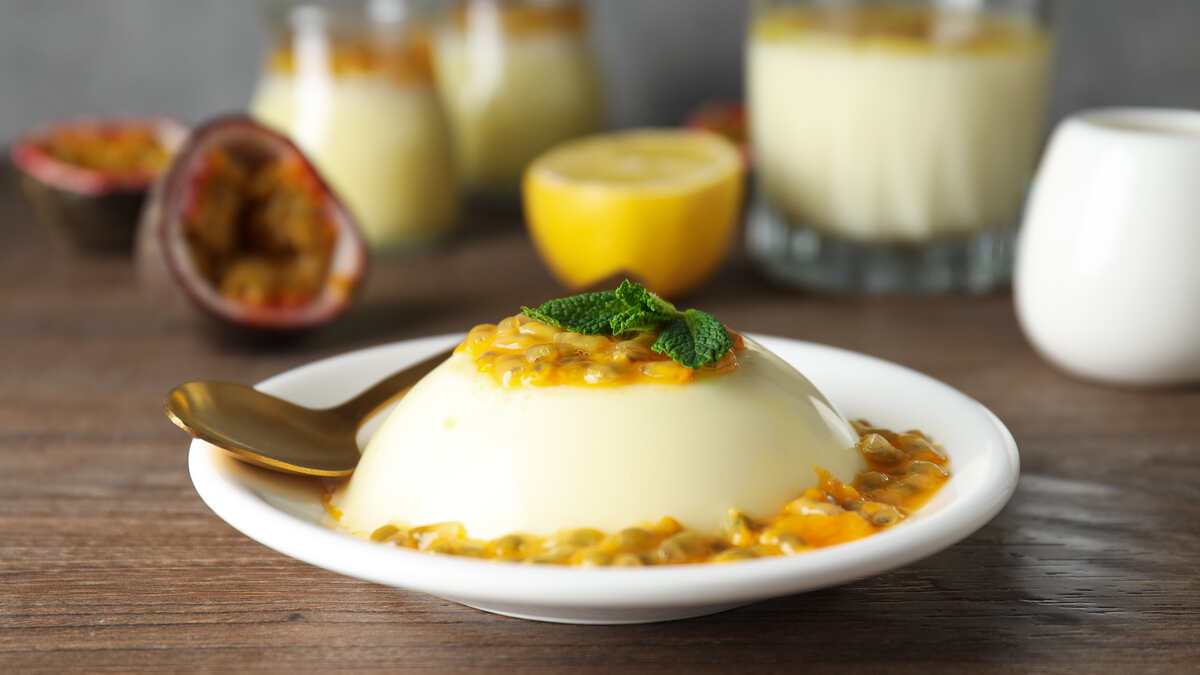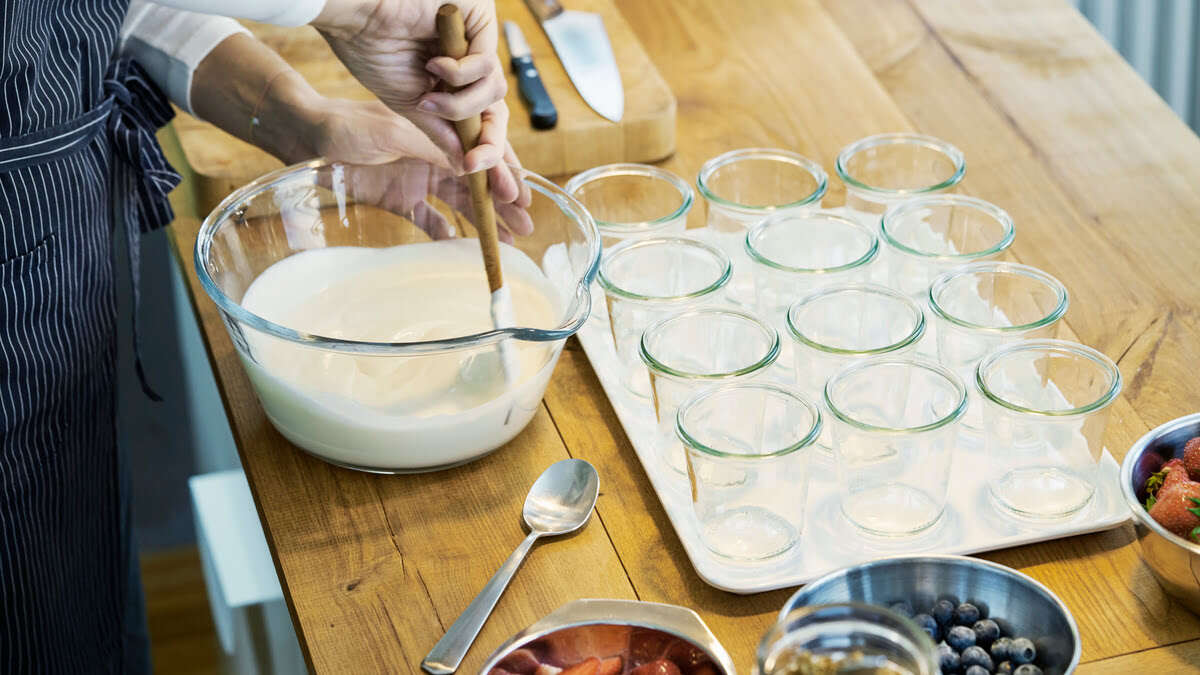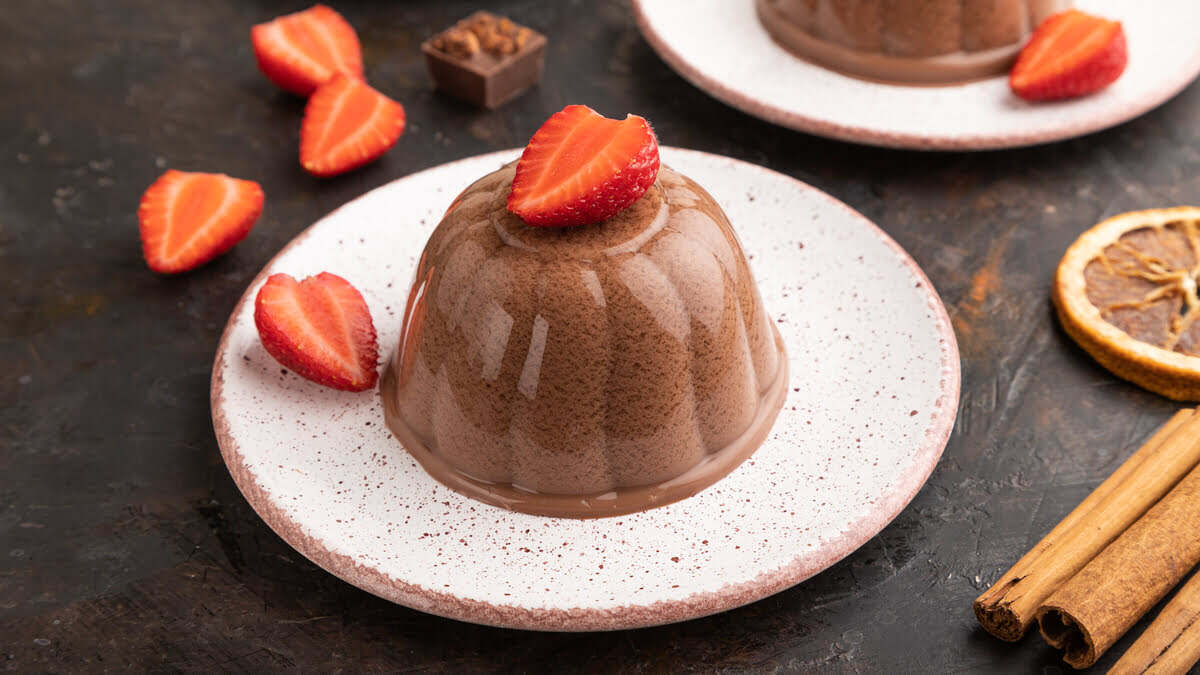Panna Cotta | What it is, where it comes from, recipes
When it comes to classic Italian desserts, panna cotta undoubtedly ranks at the very top. This velvety specialty is a harmonious combination of simplicity and refinement that has been winning over sweet-toothed palates around the world for years. What makes this delicate treat so special?
Italian culinary tradition is based on the idea that the best desserts not only please the palate but also improve the mood. Panna cotta is a perfect example of this concept—whether you enjoy it in a cozy trattoria in the heart of Tuscany or at your own table, its taste is a true feast for the senses. And the best part? Preparing this exceptional dessert at home is much simpler than it might seem!
What is panna cotta?
Panna cotta is a classic Italian dessert with a silky texture, whose name literally means “cooked cream.” Although its exact origin is shrouded in mystery, it is believed to have first appeared in the Piedmont region at the beginning of the 20th century. It’s a simple yet elegant option for lovers of subtle flavors, admired for its lightness and creamy structure.
The basic ingredients of panna cotta are cream, sugar, and edible gelatin, which gives the dessert the right consistency. The whole is usually enriched with aromatic additions such as vanilla, chocolate, cinnamon, or liqueurs, which are responsible for the unique character of this specialty. The preparation process is straightforward—heated cream combined with sugar and the chosen flavoring is mixed with previously bloomed gelatin, then poured into molds and chilled to achieve the perfect texture.
Panna cotta is extremely versatile—you can serve it on its own or with fruit sauces, caramel, nut crumble, or fresh fruit, which makes it a dessert that can be easily tailored to individual preferences.
Panna cotta and its history
One theory holds that panna cotta was created at the beginning of the 20th century, and its author was a woman of Hungarian origin living in the Langhe region of Piedmont.
At that time, access to modern gelling agents was limited, so natural thickeners were used to give the dessert the right consistency, including a broth made from fish bones. The traditional recipe was based mainly on full-fat cream, which after chilling took on its characteristic creamy structure. Italians have long valued dairy desserts, and panna cotta quickly gained recognition as an elegant and universal way to end a meal.

Some sources, however, indicate that similar desserts existed in Europe much earlier, and panna cotta may have been merely a modern interpretation of older recipes. For example, in 13th-century Denmark a dessert called “hwit moos”, or “white mousse,” was popular; it was made from milk, sugar, and natural thickeners. Its velvety texture and subtle sweetness resembled modern panna cotta, suggesting that inspirations for the Italian specialty may have come from various parts of the continent.
The popularization of panna cotta
Interestingly, the very name “panna cotta” did not appear in Italian cookbooks until the 1960s. It was then that Ettore Songia, the chef of one of the renowned restaurants, decided to introduce this dessert to his menu, giving it its contemporary form and popularizing it among a wider audience. From that moment on, panna cotta began to gain recognition not only in Italy but also around the globe. Thanks to its simplicity and possibilities for varied modifications, it became one of the most recognizable Italian desserts, which to this day appears in restaurants and many home kitchens.
Panna cotta | Recipes
Panna cotta is a dessert that delights with its simplicity while offering endless possibilities for modification. The classic version based on cream and vanilla is only a starting point—thanks to different additions and flavors, you can create extremely diverse variants of this Italian treat. Regardless of whether you prefer a classic taste, fruity accents, or modern interpretations, below you’ll find recipes that will let you prepare the perfect panna cotta in your own kitchen.
Classic panna cotta – recipe
Panna cotta in its traditional version is the essence of Italian simplicity and elegance. It is prepared from a few basic ingredients, and the final result captivates with a velvety consistency and a subtle vanilla flavor. The recipe below will allow you to create a perfectly creamy dessert that pairs beautifully with fruit sauces, caramel, or chocolate.
Ingredients (for 4 servings):
- 200 ml whole milk
- 200 ml 30% cream
- 50 g vanilla sugar or 4 tablespoons sugar + vanilla extract
- 2 level tablespoons gelatin (approx. 14 g)
- 50 ml cold water
Method:
- Prepare the gelatin
Place the gelatin in a small bowl, cover with cold water, and set aside for a few minutes to bloom. - Heat the ingredients
In a saucepan combine the milk, cream, and vanilla sugar (or regular sugar with vanilla extract). Heat over low heat, stirring regularly, until the sugar completely dissolves. When the mixture begins to lightly simmer, remove it from the heat. - Combine with gelatin
Add the bloomed gelatin to the hot but not boiling mixture. Stir thoroughly until the gelatin is completely dissolved, forming a uniform, smooth consistency. - Pour and chill
Prepare molds or ramekins, rinse them with cold water, then pour in the prepared mixture. Place the dessert in the fridge and leave to set for at least 2–3 hours.
After this time, the panna cotta should have a perfectly set yet delicate texture. You can serve it straight from the molds or gently unmold onto a plate and serve with your favorite additions such as fruit, raspberry sauce, or caramel.
Chocolate panna cotta – recipe
Chocolate panna cotta is an exquisite version of the classic Italian dessert, in which the intense flavor of dark chocolate pairs perfectly with the velvety consistency of the creamy base. It’s an excellent choice for lovers of deep, chocolatey notes and elegant dessert compositions. It tastes great on its own as well as with toppings.
Ingredients (for 6 servings):
- 500 ml 30% cream (chilled)
- 150 ml whole milk
- 110 g sugar
- 200 g finely chopped dark chocolate (min. 70–80% cocoa)
- 10 g gelatin
- 50 ml cold water
Method:
- Prepare the gelatin
In a small bowl, pour 50 ml of cold water over the gelatin and set aside for a few minutes until it blooms. - Heat the chocolate base
In a saucepan combine 300 ml cream, milk, sugar, and the chopped chocolate. Heat over low heat, stirring occasionally, until the chocolate has completely melted and the mixture is uniform. Do not bring to a boil. - Add the gelatin
Remove the pot from the heat and add the bloomed gelatin to the mixture. Mix thoroughly until fully dissolved. Allow the mixture to cool slightly. - Whip the cream
In a separate bowl whip the remaining 200 ml chilled cream until fluffy but not too stiff. Gently fold it into the cooled chocolate mixture to combine into a smooth consistency. - Chill the dessert
Pour the prepared mixture into molds or dessert glasses. Place in the refrigerator and chill for at least 2 hours for the panna cotta to set properly. - Serve and decorate
Before serving, decorate with grated dark chocolate and fresh fruit, e.g., pomegranate arils.
This intensely chocolate version of panna cotta is the perfect way to end an elegant dinner or gathering with friends. It tastes exquisite both in classic form and paired with your favorite additions.
Exotic panna cotta – recipe
Exotic panna cotta is a proposal for those who like classic desserts in a modern, tropical twist. The combination of the creamy consistency of the base with mango and passion fruit gives the dessert a unique, slightly refreshing flavor. It’s an excellent choice especially for summer parties.
Ingredients (for 4 larger servings):
- 500 ml heavy cream 36%
- 1 vanilla bean (or 1 teaspoon vanilla paste)
- 80 g sugar
- ¼ teaspoon fine sea salt
- 1 cup (230 g) Greek or creamy yogurt
- 3.5 teaspoons powdered gelatin
- 4 tablespoons cold water
- 250 ml mango pulp (from a can or fresh fruit)
- 2 passion fruits
- 40 g milk chocolate, finely chopped

Method:
- Heat the cream
In a medium saucepan combine the cream with sugar, salt, and the seeds scraped from the vanilla bean. Heat over low heat, stirring until the sugar dissolves. Remove from the heat. Add the yogurt and gently mix to obtain a uniform consistency. - Prepare the gelatin
In a separate bowl pour 4 tablespoons of cold water over the gelatin and leave for about 10 minutes to bloom. Then gently heat it over low heat, stirring until completely dissolved—remember not to boil it, as it will lose its gelling properties. - Combine the ingredients
Add the dissolved, warmed gelatin to the slightly cooled cream mixture, whisking constantly to distribute it evenly. Set aside for a few minutes to thicken slightly. - Prepare the fruit addition
In a separate bowl mix the mango pulp with the passion fruit pulp and the chopped milk chocolate. - Layer into molds
Lightly grease the inside of four bowls or molds with a neutral vegetable oil. Pour a little more than half of the cream mixture into two of them. Add ⅔ of the prepared fruit sauce to the remaining cream mixture and mix well. Fill the other two molds with this mixture. - Chill
Refrigerate the dessert for at least 4 hours, preferably overnight, so the panna cotta reaches the ideal consistency. - Serve
To make unmolding easier, dip the molds for a few seconds in hot water, then gently invert onto a plate. Serve the white panna cotta with the remaining mango–passion fruit sauce, which will further emphasize the dessert’s exotic character.
Unlike the classic panna cotta, this version uses yogurt that is not heated. To ensure even combination of ingredients and avoid lumps, it is necessary to dissolve the gelatin in warm water beforehand. Thanks to this, the panna cotta achieves a perfectly smooth texture, while its exotic flavor remains consistently velvety.
Vegan panna cotta – recipe
Vegan panna cotta is an excellent alternative to the traditional Italian dessert. Thanks to the use of plant-based milk and agar, which appears in the recipe as a substitute for gelatin, the dessert retains its silky consistency and delicate flavor. Vegan panna cotta is not only light and healthy but also easy to prepare—ideal for those avoiding animal products or looking for a lighter version of the classic recipe.
Ingredients (for 2–3 servings):
- 2 cups plant-based milk (almond, coconut, or nut milk)
- 1 teaspoon agar
- 2 teaspoons agave syrup, erythritol, xylitol, or another natural sweetener
- 2 teaspoons vanilla extract
- 1 teaspoon tapioca or potato starch
Method:
- Heat the base
Pour 1¾ cups of plant-based milk into a saucepan, add the sweetener, agar, and vanilla extract. Mix thoroughly and heat over medium heat, bringing to a boil. After boiling, cook for 2 minutes, stirring constantly so the agar dissolves well and activates. - Add the starch
In a separate vessel mix ¼ cup milk with the tapioca or potato starch until smooth. Slowly pour the mixture into the boiling milk, stirring vigorously to achieve a smooth, uniform mass. Cook for several dozen seconds more, until it thickens slightly. - Prepare the molds
Grease small bowls or molds with a thin layer of neutral-tasting vegetable oil—this will make unmolding easier after chilling. - Chill
Pour the hot mixture into the prepared molds and leave to cool at room temperature. Then transfer to the refrigerator for at least 3 hours to allow the panna cotta to set well. - Serve
To unmold easily, dip the molds for a few seconds in hot water, then gently loosen with a knife and transfer to a plate. Vegan panna cotta tastes excellent with fruit purée, fresh fruit, or a nut topping.

Thanks to the use of plant-based ingredients, this light and creamy dessert delights with flavor and works well both as an everyday sweet treat and as an elegant addition for special occasions.
Strawberry purée for panna cotta – recipe
Slightly tart, intensely fruity strawberry purée is the perfect complement to silky panna cotta. Its freshness and delicate sweetness contrast beautifully with the dessert’s creamy texture, creating a harmonious composition of flavors. It can be made not only from fresh but also from frozen strawberries, so it pleases the palate all year round.
Ingredients:
- 500 g strawberries (fresh or frozen)
- 1 packet strawberry jelly
- 150 ml hot water
- Optional: 1–2 tablespoons sugar
- Optional: 1 tablespoon lemon juice
Method:
- Cook the strawberries
Wash and hull the strawberries, then transfer them to a saucepan. If using frozen fruit, do not thaw them beforehand—simply add them directly to the pot. Add a splash of water and cook over low heat for a few minutes until the strawberries soften and release their juices. - Blend
Remove the pot from the heat and use a blender to process the strawberries into a smooth purée. For a clearer texture, you can additionally strain the purée through a sieve to remove seeds. - Add the jelly
In a separate vessel dissolve the strawberry jelly in 150 ml of hot water, stirring thoroughly until completely dissolved. Then add it to the hot strawberry purée and mix again to obtain a uniform consistency. - Chill
Set the purée aside to cool. Once it reaches room temperature, you can pour it over chilled panna cotta or place it in the refrigerator to thicken slightly before serving.
Strawberry purée is a perfect complement to panna cotta, but it also works well as a topping for other desserts, such as ice cream, crêpes, or cakes. You can also prepare the sauce from other fruits such as raspberries, blackberries, blueberries, or mango—simply replace the strawberries in the recipe and choose the appropriate jelly to achieve an equally tasty and aromatic result.
How many calories are in panna cotta?
The calorie content of panna cotta depends on its ingredients, especially the cream used, the amount of sugar, and the additions. Below are approximate values for different variants of this dessert, calculated per 100 g.
Calorie content of various types of panna cotta (per 100 g):
- Classic panna cotta (30% cream, milk, sugar, gelatin) – about 205 kcal
- Chocolate panna cotta (with added dark chocolate) – about 349 kcal
- Panna cotta with strawberry purée – about 179 kcal (weight calculated at a ratio of 70% classic panna cotta to 30% purée)
- Vegan panna cotta (plant milk, agar, natural sweeteners) – about 125 kcal
How to reduce the calorie content of panna cotta?
Lowering the calorie content of panna cotta is possible without losing its unique taste. The key step is to replace cream with less caloric alternatives, such as plant-based milk (e.g., almond, oat) or Greek yogurt. This way the dessert retains its creaminess but contains less fat. In addition, replacing sugar with natural sweeteners such as erythritol, xylitol, or maple syrup can significantly reduce the energy value of the prepared dessert.
Another effective method is to choose lighter toppings. Instead of chocolate or caramel sauce, opt for fresh fruit or strawberry purée, which diversify the flavor without an excessive number of calories.
Perfect panna cotta | Tips
To ensure your panna cotta has an ideally creamy texture and delicate flavor, it’s worth paying attention to a few key aspects during preparation. Although it is a simple dessert to make, small details can significantly affect the final quality.
Properly dissolving the gelatin
Bloom the gelatin in cold water, then add it to hot but not boiling cream. Too high a temperature can weaken its gelling properties, and insufficient dissolution will result in lumps in the dessert. For the vegan version, remember that agar-agar needs to be briefly boiled to set properly.
The right proportion of ingredients
Too much gelatin will make the panna cotta firm, while too little will prevent the dessert from setting properly. The optimal proportion is about 7 g gelatin per 500 ml liquid. In the plant-based version, use about 1 teaspoon of agar per 500 ml liquid, adjusting the amount depending on the desired consistency.
Unhurried chilling
Panna cotta requires adequate time to set—at least 2 hours in the fridge, and preferably overnight. It’s also worth avoiding placing it in the freezer, as this may affect the structure and make it grainy.
Easy unmolding
For easy unmolding, lightly moisten the molds with water or grease them with a neutral oil before pouring in the mixture. Before removing, dip the mold for a few seconds in warm water and gently loosen the edges with a knife.
Ideal toppings
Panna cotta pairs beautifully with fruit purées, nuts, chocolate, or caramel. However, keep in mind that heavy sauces can overwhelm the dessert’s delicate flavor, so it’s best to choose light and fresh additions that highlight its silky texture.

By following these tips, you’ll surely prepare a panna cotta with an excellent structure that will delight your guests both in taste and appearance. Enjoy!


